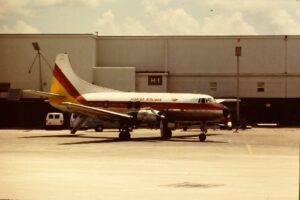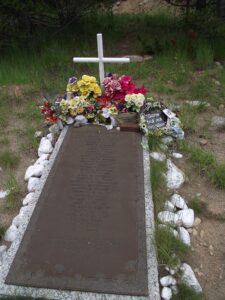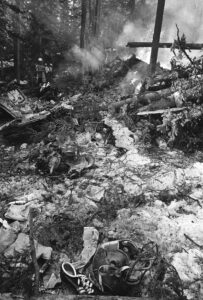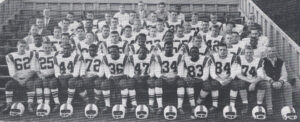 Many people have heard about the 1970 plane crash that killed the Marshall University football team, but what many people may not know is that the Marshall University crash was not the only crash that year, or even the first crash involving a football team. The first one involved the Wichita Stake Shockers football team. On Friday, October 2, 1970, at 1:14pm, in clear and calm weather, with amazing visibility, the Wichita State chartered 4-0-4 airliner crashed into a mountain peak just eight miles west of Silver Plume in Colorado. The plane, operated by Golden Eagle Aviation, the twin-engined propliner carried 37 passengers and a crew of three. Of those onboard, 29 were killed at the scene and two later died of their injuries at the hospital.
Many people have heard about the 1970 plane crash that killed the Marshall University football team, but what many people may not know is that the Marshall University crash was not the only crash that year, or even the first crash involving a football team. The first one involved the Wichita Stake Shockers football team. On Friday, October 2, 1970, at 1:14pm, in clear and calm weather, with amazing visibility, the Wichita State chartered 4-0-4 airliner crashed into a mountain peak just eight miles west of Silver Plume in Colorado. The plane, operated by Golden Eagle Aviation, the twin-engined propliner carried 37 passengers and a crew of three. Of those onboard, 29 were killed at the scene and two later died of their injuries at the hospital.
The plane was one of two 4-0-4 airliners flying the team to Logan, Utah. Three months earlier Wichita State had contracted Golden Eagle Aviation to supply a Douglas DC-6B, to fly the team to away games for the 1970 season. The four-engined DC-6 was a large, powerful aircraft that could accommodate the entire team in one plane. At the time of the contract, Golden Eagle Aviation did not own the DC-6. Nevertheless, they had made an arrangement with the Jack Richards Aircraft Company to use theirs. Unfortunately, after the agreements were made, the Jack Richards Aircraft Company DC-6 was damaged in a windstorm, so at the last minute it was unavailable for use. The two Martin 4-0-4s, hadn’t flown since 1967, so thy were quickly re-certified for flight. While it might seem like that could have been the cause of the crash, it was not. On October 2, 1970, the two 4-0-4s were ferried from the Jack Richards Aircraft Company facilities in Oklahoma City to Wichita, instead of the expected DC-6. The 4-0-4s were smaller planes, and so the team had to be split into two groups. Upon arrival in Wichita, the two aircraft were loaded with luggage and the passengers were boarded. The planes then headed west to a refueling stopover in Denver at Stapleton Airport. From Denver, they would continue to Logan Airport in northern Utah. The two planes were dubbed “Gold” and “Black” after the school colors. “Gold” was the aircraft that later crashed. It carried the starting players, head coach, and athletic director, as well as their wives, other administrators, boosters, and family. The “Black” plane transported the reserve players, assistant coaches, and other support personnel, and it took the normal route from Denver to Logan, going by way of the original flight plan and took a more northerly route, heading north from Denver to southern Wyoming then west, using a designated airway. This was less scenic, but this route allowed more time to gain altitude for the climb over the Rocky Mountains. The “Black” plane arrived safely in Utah.
The plane dubbed “Gold” took a more scenic route. The President of Golden Eagle Aviation, 37-year-old Ronald G Skipper, was the pilot flying the “Gold” plane. Normally, he would have been the pilot, but he was not rated for the 4-0-4, so he was acting as the first officer. During the flight to Denver, he visited passengers in the cabin, telling them of his plans to take a more scenic route, near Loveland Ski Area and Mount Sniktau, the proposed alpine skiing venues for the 1976 Winter Olympics, recently awarded to Denver in May. The captain of the “Gold” aircraft was 27-year-old Danny E Crocker, who occupied the right seat. While the aircraft was being refueled and serviced in Denver, First Officer Skipper purchased aeronautical sectional charts for the contemplated scenic route. The National Transportation Safety Board (NTSB) investigation report stated the First Officer testified that he intended to use the charts to help point out landmarks and objects of interest to the passengers. Unfortunately, this last-minute decision didn’t allow time to review the maps to make sure that they were traveling on a safe route, and that they were high enough to make it over the mountains.
Shortly before the crash, several witnesses described seeing an aircraft flying unusually low towards the 
 Continental Divide, which is, of course, quite high in altitude. Some witnesses who were located on higher mountainside locations, such as Loveland Pass at 11,990 feet, reported seeing it flying below them…into the mountains!! It is difficult for me to understand, how the pilots could no have seen this as a serious problem. Crash survivor Rick Stephens was a senior guard and stated in 2013, “…as we flew along over I-70, that there were old mines and old vehicles above us. I noticed we were quite a bit below the top of the mountains. I got up to go to the cockpit, which wasn’t unusual to do, and I could tell we were in trouble, looking out the window and seeing nothing but green in front of us.”
Continental Divide, which is, of course, quite high in altitude. Some witnesses who were located on higher mountainside locations, such as Loveland Pass at 11,990 feet, reported seeing it flying below them…into the mountains!! It is difficult for me to understand, how the pilots could no have seen this as a serious problem. Crash survivor Rick Stephens was a senior guard and stated in 2013, “…as we flew along over I-70, that there were old mines and old vehicles above us. I noticed we were quite a bit below the top of the mountains. I got up to go to the cockpit, which wasn’t unusual to do, and I could tell we were in trouble, looking out the window and seeing nothing but green in front of us.”
The other problem the plane had was that it was overloaded. Sadly, no one double checked the weight to make sure they were within safe limits. As the plane neared Loveland Pass, it flew up Clear Creek Valley, where it became trapped in a box canyon and was unable to climb above the mountain ridges surrounding it on three sides. It was also unable to complete a reversal turn away from the sharply rising terrain. At 1:14pm MDT, the “Gold” plane struck trees on the east slope of Mount Trelease, 1,600 feet below its summit, and crashed. The NTSB report stated that quite likely many of the passengers on board actually survived the initial impact. This was based on the testimony of survivors and rescuers. The load of fuel on board did not explode immediately. This allowed some of the survivors to escape the wreckage. Then, the passenger cabin exploded and trapped the people who were still alive. They had no way of escape. Of the 40 people on board, the death count at the scene was 29, which included 27 passengers, the captain, and flight attendant. One of the deceased passengers was an off-duty flight attendant who was assisting. Two of the initial 11 survivors later died of their injuries to bring the total dead to 31, 14 of whom were Wichita State football players. First to arrive at the crash scene were construction workers from the nearby Eisenhower Tunnel project and motorists on U.S. 6 (I-70). The first officer (company president) survived.
The National Transportation Safety Board report states that the weather did not play a role in the accident, but rather lists the probable cause to be that the pilot made improper decisions in-flight or in planning. The overloading probably played a part too, in that they couldn’t climb as fast as if they had not been overloaded. The report said that the cause was, “the intentional operation of the aircraft over a mountain valley route at an altitude from which the aircraft could neither climb over the obstructing terrain ahead, nor execute a successful course reversal, while other significant factors were the overloaded condition of the aircraft, the virtual absence of flight planning for the chosen route of flight from Denver to Logan, as well as a lack of understanding on the part of the crew of the performance capabilities and limitations of the aircraft, and the lack of operational management to monitor and appropriately control the actions of the flight crew.” It was a recipe for disaster. What I don’t understand is how the plane could have crashed less than a mile from an interstate highway that was straight and level in that area…the perfect place for an emergency landing. Why didn’t they use it?
Of course, the game was canceled, as were classes at Wichita State University. Utah State University’s football team held a memorial in the stadium where the game was to have been played…placing a wreath on the 50-yard line. Wichita State University officials and family members of the survivors were flown to Denver on an aircraft made available by Robert Docking, the Governor of Kansas. A memorial service was held on Monday, October 5th at Cessna Stadium in Wichita. The remaining members of the Wichita State team, with the NCAA and Missouri Valley Conference allowing freshman players to fill out the squad, decided to continue the 1970 season in honor of those lost. It was later designated the “Second Season.” Wichita State and Utah State had played in five of the previous six seasons, but never met again in football. Unable to fully recover from its loss,  Wichita State discontinued varsity football after the 1986 season. Roadside memorial in Colorado on Interstate 70, milepost 217 Wichita State University built a memorial for those who died from the crash called Memorial ’70. Every year on October 2 at 9 a.m., a wreath is placed at this memorial. A roadside memorial plaque listing the names of the victims is located near the Colorado crash site, adjacent to westbound Interstate 70, at Dry Gulch at milepost 217, about two miles east of the Eisenhower Tunnel. A trail to the wreck site via Dry Gulch is 0.4 miles past the memorial off exit 216.
Wichita State discontinued varsity football after the 1986 season. Roadside memorial in Colorado on Interstate 70, milepost 217 Wichita State University built a memorial for those who died from the crash called Memorial ’70. Every year on October 2 at 9 a.m., a wreath is placed at this memorial. A roadside memorial plaque listing the names of the victims is located near the Colorado crash site, adjacent to westbound Interstate 70, at Dry Gulch at milepost 217, about two miles east of the Eisenhower Tunnel. A trail to the wreck site via Dry Gulch is 0.4 miles past the memorial off exit 216.


Leave a Reply